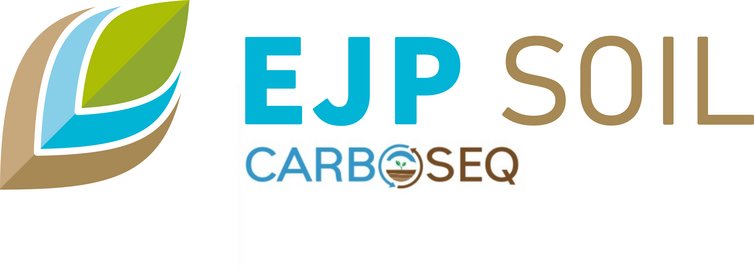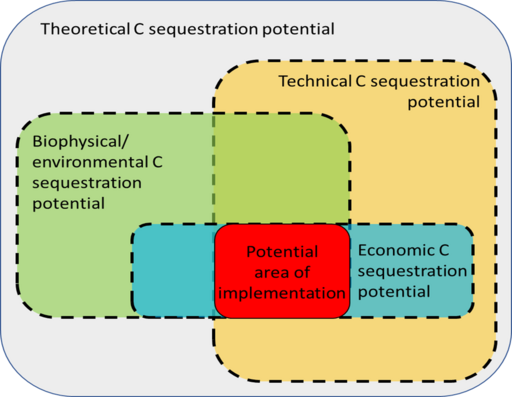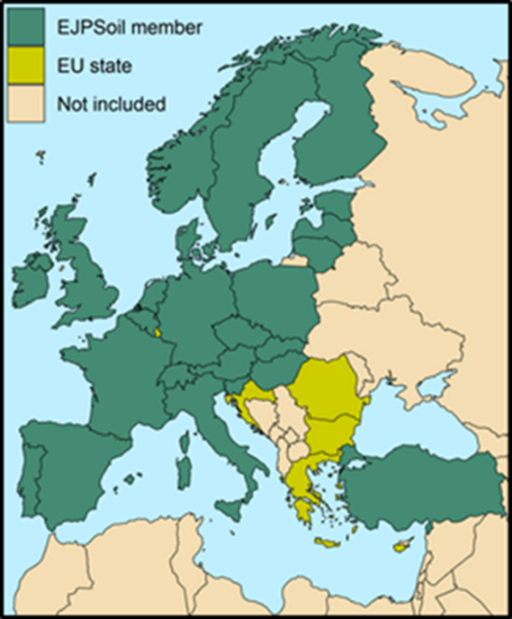CarboSeq
| Start: | 1 February 2021 |
| Duration: | 48 Months |
| Aim: | To estimate the feasible SOCsequestration potential taking into account technical and socio-economic constraints. |
| Contact: | Project manager: Axel Don (axel.don@thuenen.de) Project communication representative: Felix Seidel (felix.seidel@thuenen.de) |




Carbon sequestration in soils is a negative emission technology that can contribute to mitigate climate change. However, for European soils, a comprehensive assessment is missing on how much soil organic carbon (SOC) can be sequestered with different management options using also national data on agricultural management.
The aim of CarboSeq is thus to estimate the feasible SOC sequestration potential considering biophysical, technical and economic constraints (Fig. 1). The project is aligned with the current FAO activity for a “global SOC-sequestration potential map” (GSOCseq).
A new database
The key for achieving C sequestration in soils is an enhanced input of biomass to the soil. A new comprehensive database has been built and filled with European data from long term experiments and peer-reviewed published papers. Based on an analysis of this database the CarboSeq team identified 10 management practices that can potentially enhance SOC content of agricultural soils when implemented.
These practices cover:
- Cropping
- Increasing the share of forage legumes in the crop rotation
- Increasing the amount of crop residues
- Reduced tillage
- Irrigation
- Agroforestry with hedgerows
- Agroforestry with alley cropping
- Biochar application
- Land-use change from cropland to grassland
- Land-use change from grassland to sylvopasture
This new data collection is facilitating model runs with RothC and other soil SOC models for different management scenarios which will be compared to newly derived emission factors on EU scale (Fig. 2).
The potential area of implementation was developed together with all partners of CarboSeq and these partners will run RothC at national levels allowing to evaluate the accuracy of the EU scale model run.
Assessing European C sequestration potential
The final product of CarboSeq is the assessment of the European C sequestration potential of agricultural soils summarised in an interactive map for Europe. In this map end-users (e.g., stakeholders, or policy makers) can select a set of measures potentially leading to C sequestration in soils along different target areas, and receive (i) a map that illustrates the amount of additional SOC accrual triggered by these measures as well as (ii) information on potential positive / negative economic / environmental side effects of implementing these measures.
These maps showing the C sequestration potential in soils and the data for different management options will guide policy makers regionally specific to the most efficient agricultural management options to enhance SOC accrual to mitigate climate change effects and potentially leading to C sequestration in soils.
Policy briefs
When does soil carbon contribute to climate change mitigation?
In climate change mitigation discussions, technical terms are not always used correctly leading to unintended consequences and exaggerated expectations of the role of soil C for climate change mitigation.
Carbon stock, carbon sink - are they the same thing? And does fixing C in the soil, for example by building up soil organic C, automatically lead to climate change mitigation? In public discussions about climate protection, many such concepts often get mixed up.
Work packages
WP 1: Coordination
WP Leader: Axel Don (Thünen)
WP deputy: Florian Schneider (Thünen)
In this WP, the daily project management and administration activities are executed. The dissemination of the results will be coordinated and aligned to the overall EJP-activities.
WP 2: Crop management
WP Leader Greet Ruysschaert (ILVO)
WP deputy: Axel Don (Thünen)
In this WP we quantify SOC-sequestration and C-input to the soil effects by cover crops, crops and crops diversification, crop residues, irrigation, reduced tillage as well as hedgerows and agroforestry systems. It will provide input data for assessing the SOC-sequestration potential across pedo-climatic regions and farming conditions in Europe via an intensive data collection.
WP 3: Biochar and other soil amendments
WP Leader: Jens Leifeld (AGS)
WP deputy: Brieuc Hardy (CRAW)
In this WP, it will be examined to which extent the processing of organic material that is incorporated to soil affects SOC-stocks, considering carbonization (biochar) as well as composting, fermentation and as additional amendment also liming. The goal is to provide emission factors, describe C-input stability changes, suggest model parameters for selected amendments, and identify positive/negative side effects.
WP 4: Grassland management
WP Leader: Dario Fornara (AFBI)
WP deputy: Katja Klumpp (INRAE)
In WP4 we quantify changes in SOC-stocks of grassland systems in response to changes in key management drivers: (1) land-use change, (2) grassland management, and (3) management induced plant diversity changes. The main objective is to estimate potential SOC-accumulation under different management drivers across pedoclimatic zones in Europe.
WP 5: Non-CO2 GHG emissions
WP Leader: Jan Peter Lesschen (WR)
WP deputy: Eugenio Diaz (BIOS/BOKU)
In this WP we assess the effects of the agricultural SOC-sequestration measures on N2O (and where appropriate also CH4 and fossil fuel CO2) emissions in order to create a more complete evaluation of GHG-mitigation effects of SOC sequestration measures.
WP 6: Subsoil carbon
WP Leader: Thomas Kätterer (SLU)
WP deputy: Lars Elsgaard (AU)
In this WP we will review the literature and compile a dataset on subsoil C stocks measured in long-term field experiments for agroecosystems in Europe. Our specific objectives are to i) prepare a meta-analysis on subsoil SOC stock change rates and assess the influence of soil and climatic factors on subsoil SOC changes, and ii) synthesize soil carbon models that explicitly represent subsoil dynamics and evaluate their sensitivity to changes in stabilization factors with depth.
WP 7: Waterlogged mineral soils
WP Leader: David Wall (Teagasc)
WP deputy: Gary Lanigan (Teagasc)
This work package seeks to assess the impact of waterlogging of mineral soils and/or impeded soil drainage on SOC as well as on component C fluxes and pools across a climatic, land-use and soil-type gradient. We aim at quantifying the influence of water logging on SOC sequestration rates for dieffernt agricultural measures.
WP 8: Area of implementation for SOC-sequestration measures
WP Leader: Axel Don (Thünen)
WP deputy: Greet Ruysschaert (ILVO)
The aim in this WP is to identify the potential area of implementation for the different agricultural management options across Europe. For each of the agricultural measures for SOC sequestration considered in CarboSeq we want to assess the biophysical, technical and economical constraints that impede their implementation. Together with partners and stakeholders we will discuss these constrains in order to come up with a realistically achievable SOC sequestration potential.
WP 9: Modelling SOC-sequestration potentials
WP Leader: Roberta Farina (CREA)
WP deputy: Manuel Martin (INRAE)
In WP9 we aim (1) to interface SOC simulation models with information on soil, land use, climate, cropping systems, and agricultural management available at European scale and in each involved country; (2) to execute SOC simulation models based on baseline scenarios and SOC-sequestration scenarios, in order to provide in the end a European map of the SOC-sequestration potential. We additionally compile root:shoot data that serve as input data for the models.
Project leaders and partners
Project coordination:
Axel Don
Thünen (Thünen Institute of Climate-Smart Agriculture), Germany
Contact person: Felix Seidel (felix.seidel@thuenen.de)
Project partners:
AGS (Agroscope), Switzerland
Contact person: Jens Leifeld
EV-ILVO (Flanders Research Institute for Agriculture, Fisheries and Food), Belgium
Contact person: Greet Ruysschaert
CREA (Council for Agricultural Research and Economics), Italy
Contact Person: Roberta Farina
AFBI (Agri-Food and Biosciences Institute), United Kingdom
Contact person: Dario Fornara
SLU (Swedish University of Agricultural Sciences), Sweden
Contact Person: Thomas Kätterer
WR (Wageningen Research), Netherlands
Contact Person: Jan Peter Lesschen
TEAGASC (The Agriculture and Food Development Authority), Ireland
Contact person: David Wall
INRAE (Institut National de Recherche pour l’Agriculture, l’Alimentation et l’Environnement), France
Contact person: Lauric Cécillon
NIBIO (Norwegian Institute of Bioeconomy Research), Norway
Contact person: Daniel Rasse
BIOS (Association for the Advancement of Life Sciences Austria), Autria
Contact person: Heide Spiegel
AU (Aarhus University, Danish Centre for Food and Agriculture), Denmark
Contact person: Lars Elsgaard
CSIC, (Consejo Superior de Investigaciones Científicas), Spain
Contact person: Jorge Álvaro-Fuentes
CRAW (Centre Wallon de Recherches Agronomiques), Belgium
Contact person: Bruno Huyghebaert
ULBF (University of Ljubljana, Biotechnical Faculty, Centre for Soil and Environmental Science), Slovenia
Contact person: Marjetka Suhadolc
CZU (Czech University of Life Sciences), Czech Republic
Contact person: Ivana Galušková
EMU (Estonian University of Life Sciences), Estonia
Contact person: Alar Astover
LUKE (Natural Resources Institute Finland), Finland
Contact person: Fulu Tao
ATK (Centre for Agricultural Research), Hungary
Contact person: Eszter Tóth
LAMMC (Lithuanian Research Centre for Agriculture and Forestry), Lithuania
Contact person: Ieva Mockevičienė
IUNG (Institute of Soil Science and Plant Cultivation – State Research Institute), Poland
Contact person: Grzegorz Siebielec
INIAV (National Institute for Agrarian and Veterinarian Research I. P.), Portugal
Contact person: Maria da Conceição Gonçalves
NPPC (National Agricultural and Food Centre), Slovakia
Contact person: Rastislav Skalský
TAGEM (Ministry of Food, Agriculture and Livestock, General Directorate of Agricultural Research and Policies), Turkey
Contact person: Sevinc Madenoglu
Call text: CM2
Quantification of the potential of agricultural soils to sequester more carbon and reduce GHGs emissions at the regional / national scale in the different partner countries.
Rationale
To design adequate policies that promote climate mitigation options in agriculture, countries need to know the potential of C sequestration in their conditions, at the national or regional scale, and in particular for agricultural soils. This potential depends on the pedo-climatic conditions, on the current soil organic carbon stocks and on the management practices promoting SOC accumulation that can be implemented.
Scope
The project will aim to evaluate the technical potential to store additional carbon in agricultural soils by implementing appropriate agricultural practices in cropland and grassland. Depending on the information available in countries on current SOC stocks, agricultural practices and soil properties, appropriate methodologies should be used, with either Tier 2 or Tier 3 approaches. In addition to a technical estimate, the cost of implementing the different management options should be estimated, in order to evaluate the cost of the quantified SOC additional storage potential in agricultural soils.
Output/Expected impact
Improved spatially explicit quantification of the potential of agricultural soils to sequester more carbon under different cropping, soil management systems and land use change scenarios (e.g. grassland-cropland), in different pedo-climatic conditions, at the regional and national scale, associated with an estimate of the incurred costs. Analysis of the consequences of these options on GHG emissions. Identification of SOC sequestration potentials of the European agro-pedoclimatic regions.
Project type
A single project is expected to be funded (large, 3 to 4 years, 350 PM), gathering partners from at least 20 participating member states (Annex 1). A synergistic effort of the different partners is called for. Core activities of this consortium would concern the methodology that can be used, defining a set of reference methodologies to be used. Each involved partner would then perform the evaluation for its own country, using the selected methodology.
Available funding: 4.03 M€
Relation to EJP SOIL objectives and tasks
This project should consider outputs of EJP SOIL stocktake T2.4.3. (publication planned by the end of 2020) assessing carbon accounting systems and methods currently used in EJP SOIL countries to estimate SOC storage and storage potentials.
Articles about results from CarboSeq:
- Harbo, L. S., Olesen,J. E., Lemming, C., Christensen, B. T., & Elsgaard,L. 2023. Limitations of farm management data inanalyses of decadal changes in SOC stocks in theDanish soil-monitoring network. European Journal of Soil Science,74(3), e13379.
- Mockeviˇ cien˙ e, I.; Karˇ causkien˙ e, D.; Repšien˙ e, R. 2023.The Response of Retisol’s Carbon Storage Potential to Various Organic Matter Inputs. Sustainability, 15, 11495.
- Zhang, H.M.; Liang, Z.; Li, Y.; Chen, Z.X.; Zhang, J.B.; Cai, Z.C.; Elsgaard, L.; Cheng, Y.; van Groenigen, K.J.; Abalos, D. Liming modifies greenhouse gas fluxes from soils: A meta-analysis of biological drivers. Agriculture Ecosystems & Environment, 2022, 340.
- Harbo, L.S.; Olesen, J.E.; Liang, Z.; Christensen, B.T.; Elsgaard, L. Estimating organic carbon stocks of mineral soils in Denmark: Impact of bulk density and content of rock fragments. Geoderma Regional, 2022, 30.

